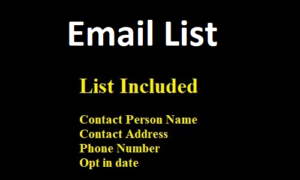Email marketing remains a vital component of a successful digital marketing strategy. To gauge the effectiveness of email campaigns and make data-driven decisions, businesses rely on key email marketing metrics. In this article, we delve into the essential metrics that marketers use to measure the success of their email campaigns and improve overall performance.
Open Rate: Measuring Email Engagement
Heading 1: Tracking Initial Interaction
The open rate is a fundamental email marketing metric that indicates the percentage of recipients who opened an email. It reflects the effectiveness of subject lines, sender names, and overall email relevance. A high open rate suggests that the email content was engaging Oman Email list enough to prompt recipients to open and read the message.
Click-Through Rate (CTR): Evaluating Content Relevance
Heading 2: Analyzing Interaction Levels
The click-through rate measures the percentage of recipients who clicked on at least one link within the email. A high CTR indicates that the email content and call-to-action (CTA) were relevant and compelling, encouraging recipients to take further action. Marketers use CTR to assess the effectiveness of email content and optimize CTAs for better engagement.
Conversion Rate: Assessing Action and Results
Heading 3: Measuring Goal Achievement
The conversion rate is a critical metric that calculates the percentage of recipients who completed the desired action after clicking on a link within the email. This action could be making a purchase, signing up for a webinar, or downloading a resource. The conversion rate indicates the success of email campaigns in achieving specific goals and driving desired outcomes.
Bounce Rate: Managing Deliverability
Heading 4: Addressing Email Delivery Issues
The bounce rate represents the percentage of emails that were not successfully delivered to recipients’ inboxes. Bounces can be classified into two categories: hard bounces, which occur due to permanent delivery failures, and soft bounces, which are usually temporary delivery issues. Monitoring bounce rates is crucial to maintaining email deliverability and a clean email list.
Unsubscribe Rate: Understanding Subscriber Preferences
Heading 5: Managing Opt-Outs
The unsubscribe rate indicates the percentage of recipients who opted out of receiving future emails from the sender. While an unsubscribe might seem negative, it provides valuable insights into B2B Lead subscriber preferences and content relevance. Monitoring the unsubscribe rate helps businesses tailor their email content and frequency to better align with subscriber preferences.
Conclusion:
Key email marketing metrics play a vital role in assessing the success of email campaigns and guiding marketers in making data-driven decisions. By tracking metrics such as open rate, click-through rate, conversion rate, bounce rate, and unsubscribe rate, businesses can measure engagement, content relevance, goal achievement, and email deliverability. Analyzing these metrics empowers marketers to optimize email campaigns, personalize content, and nurture meaningful relationships with their audience. In the ever-evolving landscape of email marketing, relying on key metrics enables businesses to continually improve performance and achieve greater success with their email campaigns.







